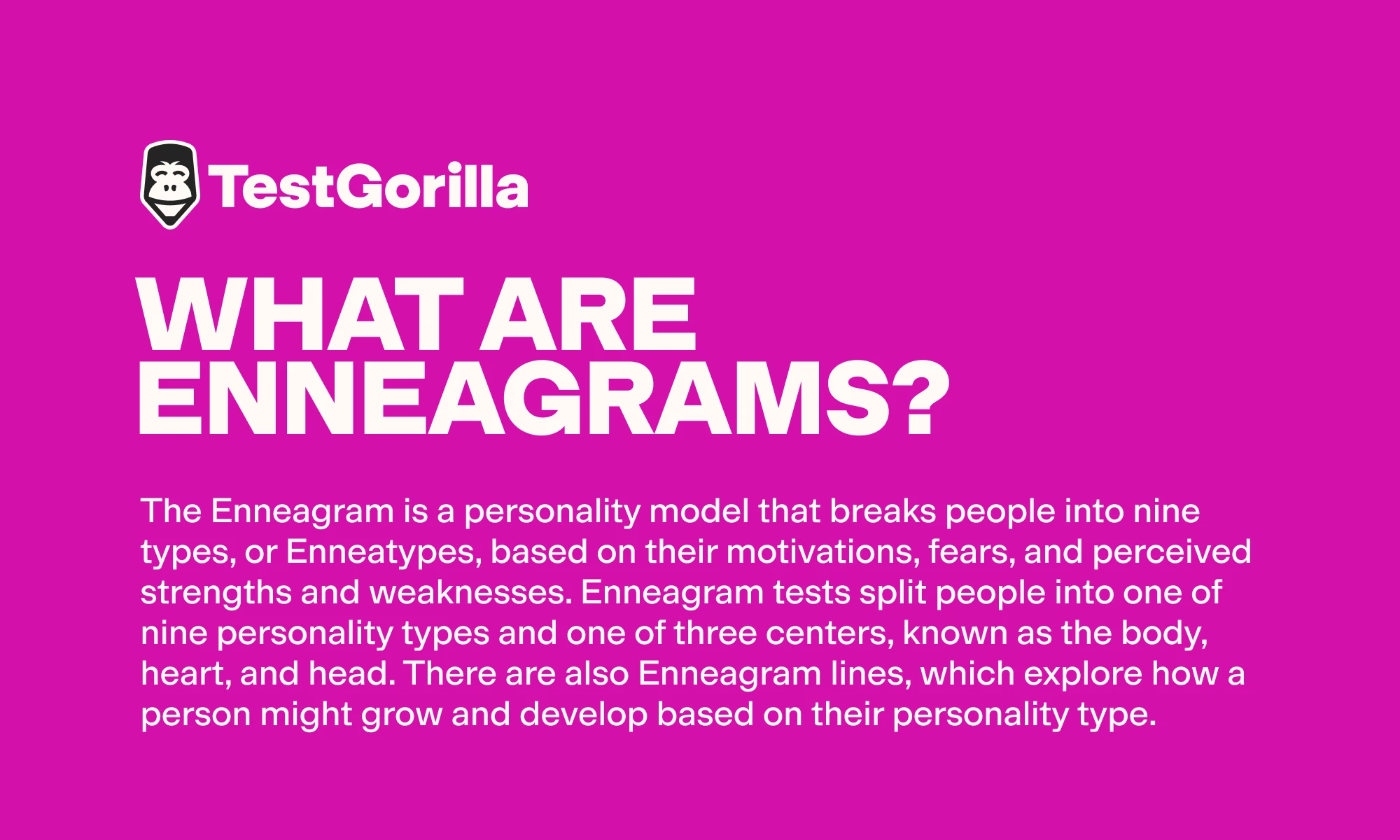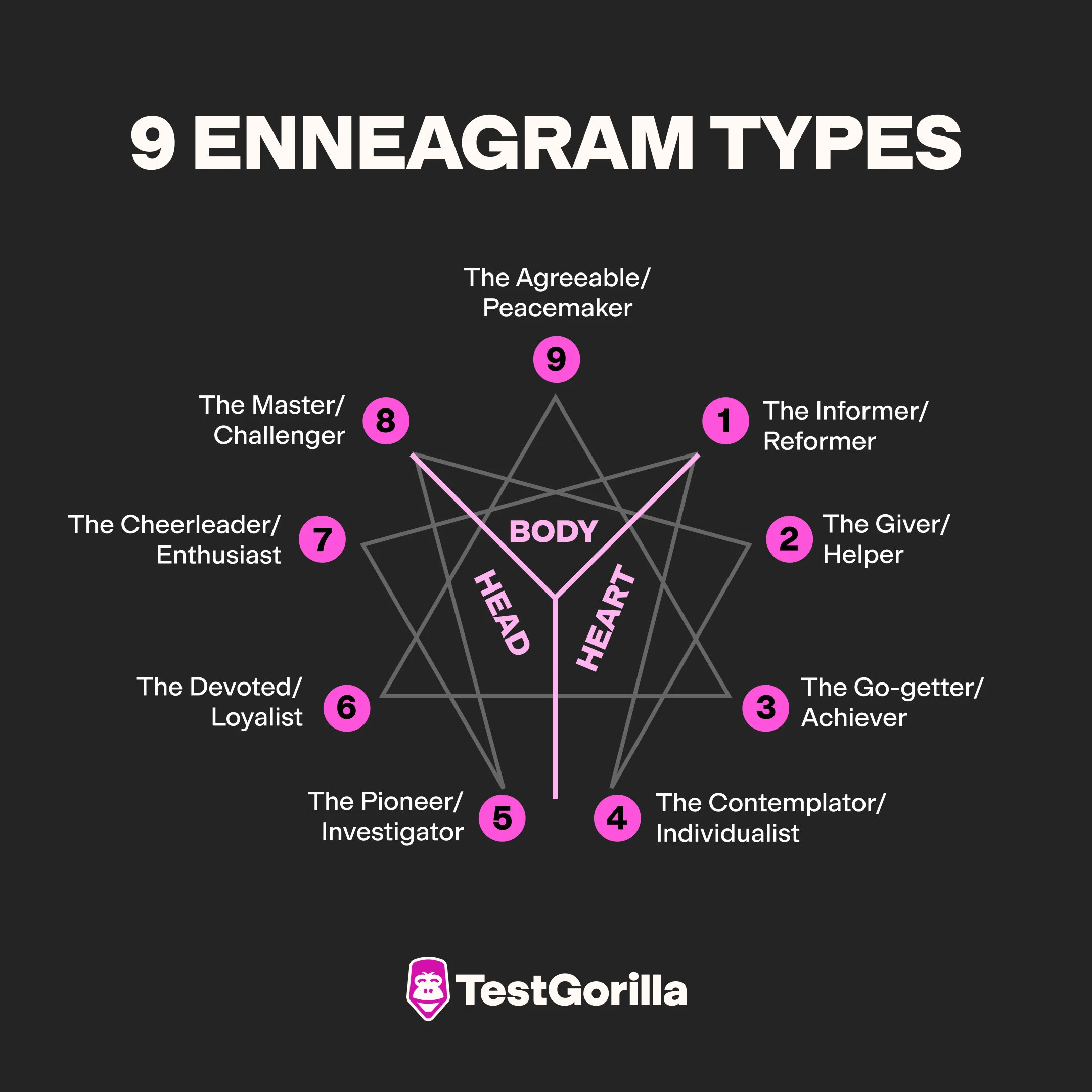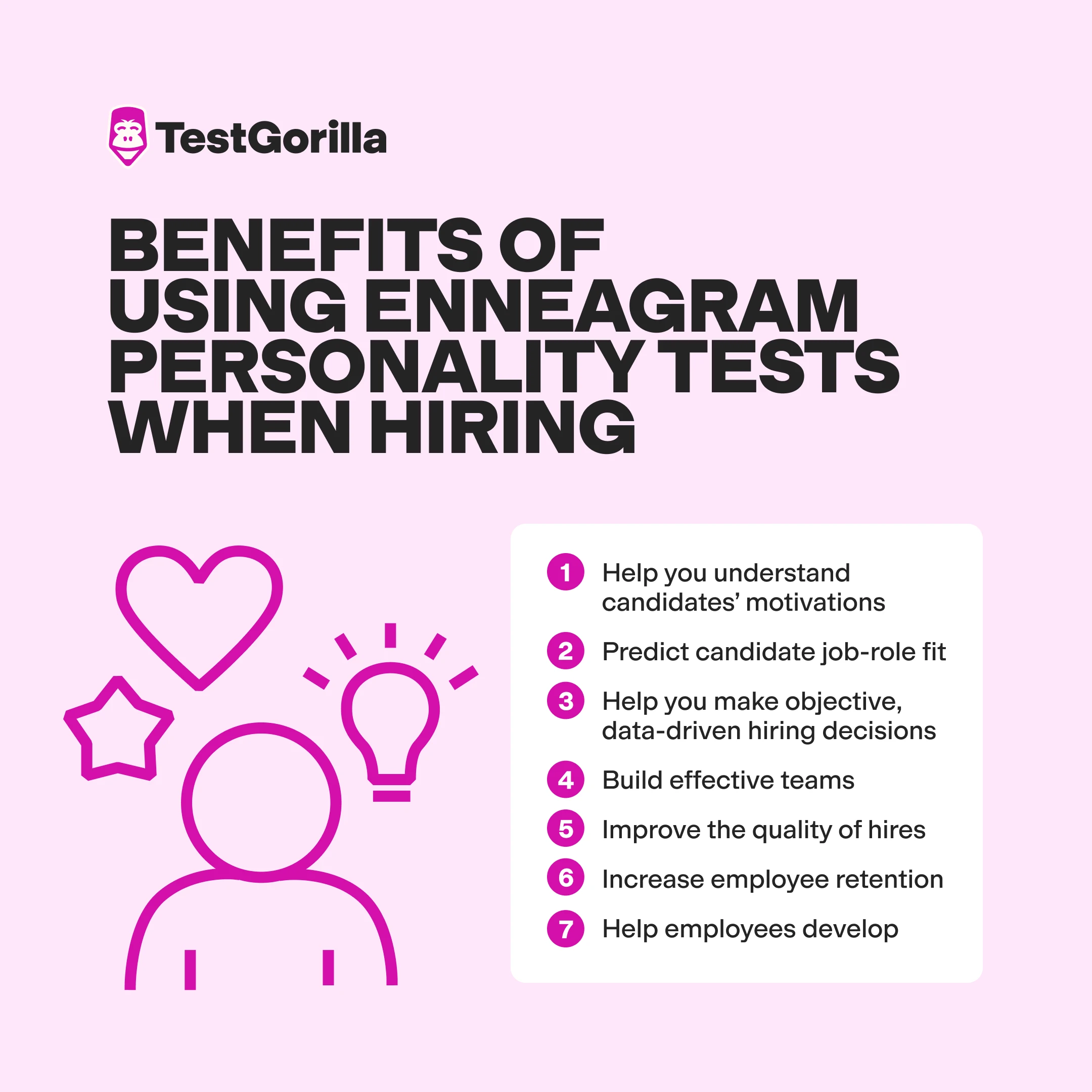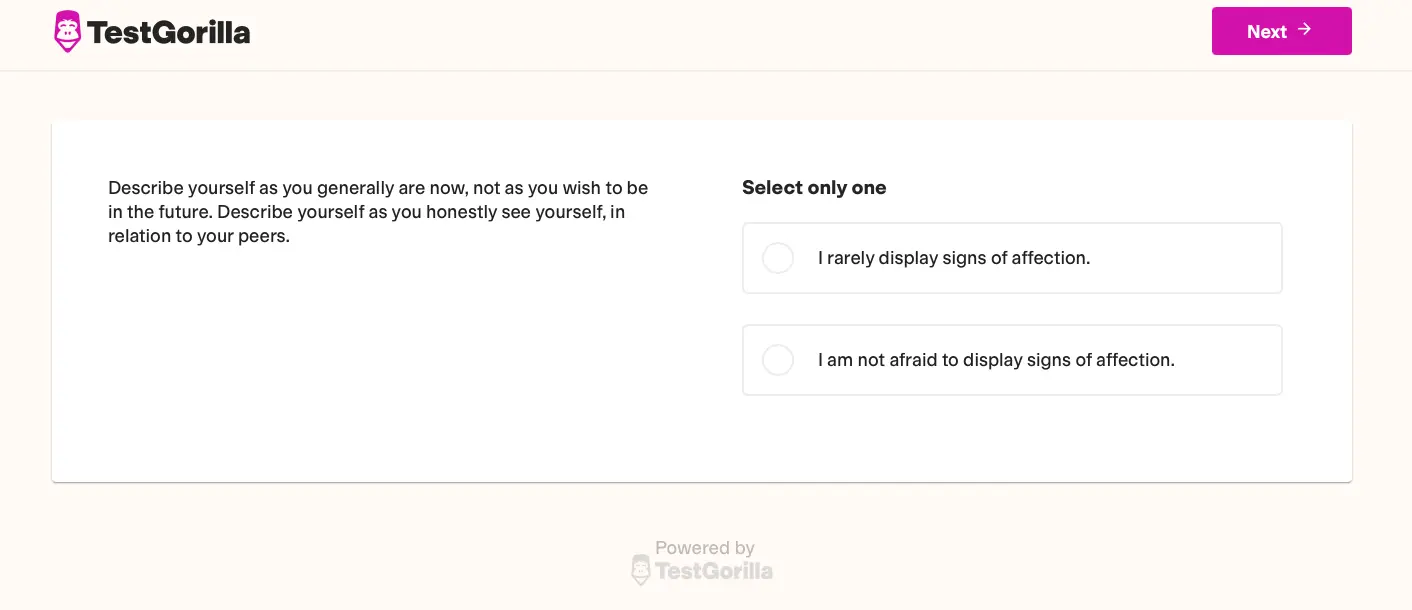The recruitment process gives little time to get to know your applicants, so it’s hard to predict how the people you hire mesh with your current teams and projects.
Thankfully, assessing personalities with the Enneagram test helps you learn more about people’s strengths, weaknesses, fears, and core motivations.
But what is the Enneagram test useful for in practice? In this guide, we explore the Enneagram system and how it can support more efficient hiring alongside skills testing.
What are Enneagrams? An overview
The Enneagram is a personality model that breaks people into nine types, or Enneatypes, based on their motivations, fears, and perceived strengths and weaknesses.
Research into the effectiveness of the Enneagram theory is ongoing. However, several studies show that, although there is no such thing as the most accurate Enneagram test, this personality testing can produce stable, precise analyses.
Likewise, knowing your Enneagram type can positively influence your self-discovery and self-development.
Many recruiters use the Enneagram alongside technical talent assessments to find well-rounded candidates to support specific roles and departments.
A brief history of Enneagrams
The first evidence of the Enneagram’s use in understanding personality is in the teachings of Oscar Ichazo, which date back to the 1950s.
In his study of “Protoanalysis,” Ichazo referred to the “Enneagram of Personality” and its related concepts of passions, virtues, holy ideas, and ego-fixations. Ichazo used these concepts to help people achieve self-realization and self-awareness.
Later on, Chilean psychiatrist Claudio Naranjo applied the Enneagram of Personality in the context of psychology. He taught Enneagram theory in the US during the 1970s, leading to its continued use today.
David Daniels later popularized the Enneagram model in his 2000 book “The Essential Enneagram,” co-authored with Virginia Price. Many believe the book has helped to keep Ichazo’s model in the mainstream consciousness.
By 2008, studies showed that eight out of 10 Fortune 500 companies used personality tests such as the Enneagram to analyze candidates during recruitment.
What’s more, people often use free Enneagram test platforms to learn more about their strengths and weaknesses outside of work.
However, free tests are typically limited and superficial compared with professional, paid tests designed to support recruitment and training decisions.
How Enneagrams work
Enneagram tests split people into one of nine personality types and one of three centers, known as the body, heart, and head.
However, there’s sometimes a crossover between personality types, which is why each Enneagram has two wings. Each wing is essentially a subtype that embodies the traits of two of its adjacent Enneatypes.
There are also Enneagram lines, which explore how a person might grow and develop based on their personality type.
Lastly, there are levels of development that pinpoint where people are on their personal growth journeys.
Let’s explore each of these facets in more detail, starting with Enneagram typology.
9 Enneagram types
The Enneagram system centers around a circle diagram that shows each of the nine personality types and how they connect.
Points around the circle are labeled from one to nine, with nine at the top, and lines within the circle connect the types together. These lines also create small triangles to the left and right of each type, which are the Enneagram wings – where there is a crossover between two types.
Around the circle, the numbers are grouped into triads of head, heart, and body, which are also known as centers of intelligence. We explore these triads in a little more detail further down.
Here’s a quick breakdown of all nine Enneagram types.
Enneagram Number and Type | Grouping/Triad |
Type 1: The Informer/Reformer | Body |
Type 2: The Giver/Helper | Heart |
Type 3: The Go-getter/Achiever | Heart |
Type 4: The Contemplator/Individualist | Heart |
Type 5: The Pioneer/Investigator | Head |
Type 6: The Devoted/Loyalist | Head |
Type 7: The Cheerleader/Enthusiast | Head |
Type 8: The Master/Challenger | Body |
Type 9: The Agreeable/Peacemaker | Body |
Now, let’s explore each Enneagram type in detail.
Type 1: The Informer/Reformer
Improvers are idealistic, purposeful, and a perfectionist. They set high standards for themselves and others and have a strong moral compass.
Type one types can be judgmental, impatient, or uncompromising in pursuit of their goals, but they also strive to explain their goals to others.
Strengths | Weaknesses | Desires | Fears |
Rational Focused Self-disciplined Principled | Perfectionist Rigid Prone to burnout | Finding solutions Perfecting projects Being useful | Losing control Being wrong Making immoral decisions |
Type 2: The Giver/Helper
The Giver is generous, friendly, and empathetic. They seek connection with others and have a deep desire to feel needed.
Enneagram Number Twos can be good listeners but also have a tendency to put their own needs behind those of others.
Strengths | Weaknesses | Desires | Fears |
Warm and positive Dedicated to tasks Highly sociable | Need approval Struggles with feedback Put themselves last | Helping others Making connections Seeing others grow | Not being valued Being isolated Unworthiness |
Type 3: The Go-getter/Achiever
Type three, or the Go-getter, also known as the Achiever, is goal-driven, confident, image-conscious, and energetic. They define their success by the goals they’ve accomplished and can be strong leaders when working in teams.
However, individuals with the Go-getter personality type can also be highly competitive or insecure.
Strengths | Weaknesses | Desires | Fears |
Ambitious Highly productive Charismatic | Cares deeply about opinions Fears failure Prone to burnout | Being valued Accepted by peers Recognition for achievements | Being seen as a failure Not being recognized Not being loved |
Type 4: The Contemplator/Individualist
The Contemplator, or the Individualist, is sensitive and reserved. They are often highly creative and excel at taking inspiration from their environment.
Type four people who have a Contemplator personality can be moody, and they often prefer to maintain distance from others.
Strengths | Weaknesses | Desires | Fears |
Self-reflective Authentic Emotionally deep | Prone to mood swings Can become withdrawn Struggles with change | Personal growth Creative expression Meaning in all they do | Lacking identity Mundane pursuits Lacking impact |
Type 5: The Pioneer/Investigator
The Pioneer is curious, innovative, and independent. They often have an entrepreneurial flair since they can imagine the world in ways that others don’t see.
However, they can also act obsessively and may have trouble relating to colleagues who can’t grasp the complexity they see.
Strengths | Weaknesses | Desires | Fears |
Highly analytical Focuses on details Self-motivated and reliant | Can overanalyze Can struggle to relax Struggles to build relationships | Learning and building knowledge Feeling competent and helpful Being self-sufficient | Incompetence Being helpless Becoming overwhelmed |
Type 6: The Devoted/Loyalist
The Devoted, also called the Loyalist, is hard-working, cooperative, and anxious. Type six individuals often work well in teams, going above and beyond for projects they believe in.
However, they can also be indecisive and take on more stress than is healthy in some situations.
Strengths | Weaknesses | Desires | Fears |
Trustworthy Hard-working High attention to detail | Overthinking Pessimistic Struggles with change | Security External validation Mutual trust | Losing support Betrayal Being unprepared |
Type 7: The Cheerleader/Enthusiast
The Cheerleader, also known as the Enthusiast, is high-energy, extroverted, and excited about new experiences. Cheerleaders’ energy is contagious, and they’re eager to take on new projects or learn new skills.
Their enthusiasm can lead them to become distracted, so it’s important that people with this personality type have a clear direction to follow.
Strengths | Weaknesses | Desires | Fears |
Optimistic Great at multitasking Open and spontaneous | Struggles to focus Gets bored easily Can be self-centered | Feeling happy Finding adventure Having purpose | Boredom Negative feelings Missing out on experiences |
Type 8: The Master/Challenger
The Master is confident and decisive, and can therefore be a strong leader and problem-solver. They genuinely care for others, especially those on their teams.
However, they are also confrontational and may have issues with micromanaging others, or taking on too much control.
Strengths | Weaknesses | Desires | Fears |
Assertive Makes fair, reasoned decisions Stands up for others | Can be impulsive Can become isolated Takes too much control | Trust Taking control Protecting others | Vulnerability Showing emotion Opening up |
Type 9: The Agreeable/Peacemaker
The Agreeable is easy-going and supportive of others. They can help broker compromises between team members and encourage people to work together. On the other hand, they’re highly anxious about conflict and avoid actions that might upset others.
Strengths | Weaknesses | Desires | Fears |
Highly tolerant Great mediator Optimistic | Struggles with confrontation Prioritizes others too much Can shut down in difficult situations | Peace and harmony Productive collaboration Inner stability | Getting shut out Any kind of conflict Losing people and control |
The centers
As mentioned, Enneagram personality types are divided into three groups known as centers of intelligence. These are:
Body-centered (Types Eight, Nine, and One): Individuals with these personality types tend to act based on their instincts
Heart-centered (Types Two, Three, and Four): People with these three personality types act based on their feelings
Head-centered (Types Five, Six, and Seven): Individuals with these personality types act based on their thoughts
The wings
The nine Enneagram numbers or types represent core personalities. However, many people don’t fall precisely into one of those personality types but rather overlap with adjacent types.
The two personality types on either side of an individual’s dominant personality type are the “wings.”
An individual’s core personality might include many elements of one or both wings. They might also find that one wing of their personality is more prevalent at certain times, such as when stressed.
Lines
There are two sets of lines in the Enneagram diagram: 3-6-9 and 1-4-2-8-5-7-1. These lines indicate directions in which an individual’s personality may grow or develop.
Therefore, someone whose core personality type is the Contemplator may develop traits of the Improver or the Giver over time.
Learning to channel traits from these adjoining personality types is another way individuals can grow. They still retain their core personality, but they may be able to develop a more flexible emotional and psychological response to handle different situations.
Levels of development
Finally, each basic type has nine levels of development. These represent how intensely an individual experiences the positive and negative traits of a particular personality type.
We measure these levels on a scale of one to nine. So, level one represents the highest and healthiest level of development, while level nine represents the least healthy form.
Let’s look at an example. A level one Cheerleader or Type Seven is thankful for their experiences and feels at ease without a constant stream of new experiences. On the other hand, a level nine Cheerleader is often highly restless, depressed, and in need of constant stimulation.
Individuals can move up and down the levels of development for their core personality over time.
Therefore, it’s often worth running Enneagram tests on employees long after recruitment as part of personal development plans.
Doing so can help people observe their personal growth over time and set new goals. Coaches and managers can also spot opportunities to support people and learn more about how their staff is impacting their workplace culture.
Research suggests that using Enneagram theory in the workplace can help people build emotional intelligence, learn more about personal motivators, and develop greater self-awareness.
All three of these can lead to a healthier, more communicative, and more productive workplace. With TestGorilla’s Enneagram personality test, it’s easy to touch base with employees at any training checkpoints you set.
Get to know your employees better
Whether during hiring or after onboarding, TestGorilla’s Enneagram test can help you tap into what makes your people tick.
The best insights on HR and recruitment, delivered to your inbox.
Biweekly updates. No spam. Unsubscribe any time.
How Enneagram personality tests help hiring managers
The Enneagram assessment can be a powerful tool for hiring managers and recruiters. It provides deep insights into candidates’ personalities and their suitability for specific job roles and teams.
Studies are still ongoing, but research suggests that the Enneagram is particularly useful because it actively measures explicit and implicit personality traits. That means you get a clear picture of how your candidates behave long before the interview stage.
Used effectively, the Enneagram personality test can:
Help you understand candidates’ motivations: The personality types described by the Enneagram assessment point clearly to the motivators that drive different individuals
Predict candidate job-role fit: Certain job roles are better suited to particular Enneagram personality types. For example, a customer service job requires someone who is helpful, cheerful, and patient.
Help you make objective, data-driven hiring decisions: When used alongside cognitive ability and job-specific skills tests, you can get a fuller picture of a candidate based on data
Build effective teams: The best teams consist of individuals with different personality types since they may bring new ways of looking at problems and communicating within the team
Improve the quality of hires: A deeper understanding of a candidate and how they work gives you the best chance of hiring the right person for the job
Increase employee retention: You have an idea of how to best support the employee, not only to produce their best work but also to ensure they are satisfied and fulfilled in their role
Help employees develop: Managers who understand the core personality traits of new employees can better anticipate how they prefer to work and what areas they may need support in
When is an Enneagram test most useful in hiring?
Enneagram tests complement a range of skills tests, including those measuring cognitive ability and job-specific talent. You can start exploring hundreds of tests like these when you sign up for our Free forever plan.
Remember, the results of an Enneagram personality test should never be used to make final hiring decisions but rather as a way to understand the motivations, fears, and perceived strengths and weaknesses of candidates you’ve vetted through skills-based tests and structured interviews-
TestGorilla: The Enneagram test created by industry experts
TestGorilla’s Enneagram test is designed to be quick and easy for takers, while reports are comprehensive and detailed for recruiters.
Our customizable test is just one of more than 400 available for you to explore in our ever-growing library. Using our talent discovery platform, you can edit and arrange scores of Enneagram questions to send to applicants before you decide who to interview.
During the Enneagram assessment, candidates simply need to choose between different statements they feel best represent their personalities. Here’s an example:
We designed our questions to ensure candidates can answer as openly and as honestly as possible, and the answers they give affect overall scoring for each Enneagram type. Check out some more preview questions for a deeper dive.
At the end of the test, you get a complete breakdown of candidate scores, which you can use to cross reference with other results to organize and prioritize your hiring pool:
If you’re hiring a large volume of people for a specific role, these insights are particularly useful. For instance, when you recruit for a healthcare position, you might have some highly-skilled Type Twos you’d like to take to interview.
Remember, a good skills-based hiring plan includes more than just personality tests. You can use our talent discovery platform to measure up to five technical and soft skills at once – it’s a great way to narrow down well-rounded candidates.
But don’t just take our word for it. Companies like Solid Solutions Management have seen vast improvements in hire quality since partnering with TestGorilla. Specifically, the engineering software firm has adopted personality testing to understand its candidates better.
Take a TestGorilla tour
Want to see how our talent discovery platform works in practice? Sign up for a free 40-minute demo and let one of our friendly colleagues give you the complete lowdown.
Get to know your candidates better with the TestGorilla Enneagram system
So, what is the Enneagram test? It’s a popular personality gauge that breaks down people into nine types based on what drives them.
For recruiters, the Enneagram system’s insights can be a great support in narrowing down large waves of candidates. After all, you want to hire people who are motivated and talented and who add to your culture, not just blend with it.
With TestGorilla’s Enneagram test, understanding candidates’ personality types has never been easier or more efficient. As part of a multi-measure assessment, you can learn about what makes your applicants tick and measure their critical skills.
Want to break away from resumes and references? Try the Free forever plan of our talent discovery platform and let candidates show you what they can do.
What is the Enneagram test? FAQs
Let’s finish this guide with some frequently asked questions.
How should I use an Enneagram test during a hiring campaign?
Match your job requirements with Enneagram personality types
Assess personality types within your company
Consider compatibility within teams
Provide an Enneagram test after selecting initial candidates, and before interviewing
Offer technical and soft skills tests alongside the Enneagram as part of a multi-measure assessment
Include personality type-specific questions in interviews
Ask references about candidates’ personalities
Are Enneagram tests accurate?
Although the Enneagram test can be a helpful tool for hiring, Enneagram test results aren’t perfect. Some individuals might choose statements that reflect how they would like to be seen by others rather than how they actually behave. You can counteract this by posing situational questions, e.g., how they might react given a specific work problem. Their answer is likely to reflect their core personality.
How can I administer the Enneagram test?
Choose a reputable skills test provider that offers Enneagrams, such as TestGorilla
Review and edit suggested questions to your hiring needs
Share a link to your Enneagram test with applicants during recruitment
Wait for candidates to complete the test and check the results
Prioritize applicants with Enneagram profiles that fit your culture and the role(s) you’re hiring for
You've scrolled this far
Why not try TestGorilla for free, and see what happens when you put skills first.




















